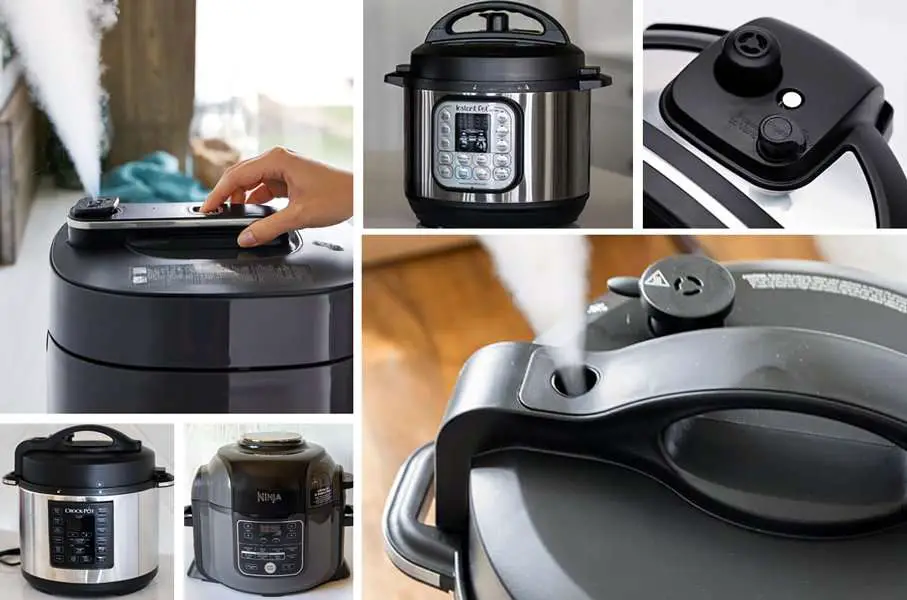What Is Quick Release Instant Pot
A quick release instant pot will release the pressure in no time. If you want to cook food quickly, go with this method.
As soon as the instant pot beeps, you turn the pressure release valve to open or the quick release valve to venting. Doing so will release the steam from the instant pot in no time.
However, be cautious while depressurizing the instant pot with a quick release method. Stay away from the steam release valve and consider using a potholder or a silicon glove to protect yourself from burns.
When you see or hear the float valve drop down, it means the quick pressure release process is over. It is now safe to open your Instant pot.
Did You Know We Have A Podcast
We started the Magic With Gadgets podcast in the January of 2021 as a way to offer a different way to enjoy Recipe This. It focuses on cooking with kitchen gadgets. You can find out more about our podcast here.
With twice weekly episodes through September to December. This is episode 2 of the second season and you have the choice between reading this post, listening to the podcast or both.
If you would like to stay in the loop with our podcast, I recommend you subscribe below:
When Do I Use The Natural Release Function
The natural release function is perfect for when youre planning to cook meats or grill your protein. This will ensure that the meat is super soft and tender.;
You can also ideally use this function when it comes to cooking foods that are foaming. Steel cut oats, pasta and soup are good examples.;
Avoid putting in veggies that cook quickly and delicate seafood .;
Amazon always has great prices and sales on Instant Pots. I’ve ordered a few there myself.
Recommended Reading: Which Instant Pot To Get
What Is Natural Release Instant Pot
As the name suggests, you need to leave your instant pot to work on its own for this method. Your instant pot will release the pressure once it depressurizes on its own.
Your instant pot will signal you with a beep stating that it has completed the cooking cycle and will automatically start releasing the pressure.
To figure out if your instant pot has released its steam completely, completely check the float valve for this. The natural release process is complete if it drops down.
Once the pressure is released it is now safe to open the lid. Remember, you will only be able to open the lid if the pot is depressurized. Never try to open the lid before this process.
Sealing Ring Isnt Properly Seated

The final thing that could be wrong with the pressure system of your instant pot is the sealing ring. In order to generate and maintain a reliable seal, any appliance will need to use a rubber sealing ring. In the case of your instant pot, the sealing ring can be found within the lid and is designed to be removed and replaced after a while of use.
If your sealing ring isnt properly seated, is missing, or has hardened due to time and use, then it will not be able to create a proper seal. This means that while your instant pot may have been supplying heat to the inner chamber, you will not have been effectively cooking your food.
Recommended Reading: How To Cook Black Beans In Instant Pot
What Is A Quick Pressure Release
This is when you turn the pressure release valve/quick release valve to “open” or “venting” at the completion of the cooking cycle. This forces the steam to release from the Instant Pot quickly.
When you hear the “beep/s” that the cooking cycle has been completed, immediately switch the pressure/steam release valve ; to “venting”.; This opens the vent and allows all accumulated steam/pressure to release from the Instant Pot right away.
Use caution when switching the pressure release/quick release valve to venting. Use a pot holder or silicone glove to avoid burns and always keep your face/hands away from the steam release valve.
You will know the Quick Pressure Release is complete when you see/hear the float valve drop down. Once that has happened it is safe to open the Instant Pot.
When to use Quick Pressure Release
A Quick Pressure Release means pressure/steam within the Instant Pot is released very quickly so its perfect for foods that are delicate and those that you don’t want to cook longer than the cooking cycle .
Q: When Do I Use A Natural Pressure Release
Using a natural pressure release allows the cooking to stop gradually. You dont want to open the valve quickly when the ingredients inside could be foaming. Youll get foam shooting out through the valve, so use a natural pressure release when making steel cut oats, a large pot of soup or pasta.
You also want to use a natural release for;large cuts of meat. Just like youd let meat rest after grilling it, a slow natural release is said to let the meat relax and be more tender.
Our Favorite Recipes to use Natural Pressure Release
During a natural release, the;cooking continues so you need to take that in to account when determining your cook time. If a recipe calls for a Quick Release, you can use a Natural Release if you prefer, but reduce the cook time.
Read Also: How To Cook Ribs In Instant Pot
Which Should You Use
Which release method you choose depends on what kind of food youre cooking. Rick Martinez, host of Food Networks Pressure Point and resident Instant Pot expert follows this simple rule, “Generally, foods that are cooked to a specific temperature, like meat, fish and poultry should be quick released so they don’t continue to cook. Foods like rice, grains and dried beans should be naturally released because they benefit from continued hydration in a warm, humid environment with a gently falling temperature.” Natural release or a partial natural release is also your best choice for soups, mac and cheese and runny braises where you are dealing with a lot of hot liquid; a quick release could cause it to spew out of the valve everywhere.
Related Links:
How Long Does The Instant Pot Take To Warm Up
An instant pot takes about 10-15 minutes to warm up depending on the number of contents present in the instant pot. The more the contents inside the instant pot, the longer It will take to come to pressure. The pressure is released from the instant pot in two ways.;
In a quick or natural release, the control knob above the pot from the seal is tuned resulting in quick depressurization of the pot. In case of a slow-release, the pot is allowed to sit and release pressure slowly and naturally. This is particularly important when cooking delicate foods like beans.
Recommended Reading: What To Do If Your Instant Pot Says Burn
How To Quick Release Instant Pot
Once you know how to quick release, you can also opt for a combination approach. Some people find its a good idea to let the Instant Pot natural release for a few minutes first, and then apply a little quick release action to let off more steam.
Best Recipes for the Quick Release Setting
How To Release An Instant Pot Without The Natural Release
This is a bit of a tricky one. While the pressure within the instant pot is particularly high, the lid will be locked in place. This is done for safety, as rapid decompression done in a non-controlled manner can be very dangerous indeed.
Without a natural release, youll have to use the quick-release function of the instant pot to release the pressure. Therefore, simply press the button or twist the handle of your release valve in order to release steam.
Make sure youre careful not to touch the steam that comes out of the instant pot it will be exceptionally hot, and likely to burn you.;
Don’t Miss: What To Cook In Instant Pot
Instant Pot Natural Pressure Release
I got my first ever instant pot on the 25th of November 2016. I remember the date well because it was my daughter Sofias 2nd birthday. We were doing the birthday thing and I was staring at my instant pot sat in its box and was super excited to get it out and see what all the fuss was about.
The next day the hubby and I, did just that and made instant pot broccoli, instant pot salmon and broccoli and a few other recipes, and of course the instant pot water test.
We had already been in the instant pot facebook groups and had learnt all the instant pot jargon and were ready to go.
But for those of you that havent learnt about the instant pot first, all that instant pot jargon is probably driving you crazy and the biggest one of all, is often instant pot natural pressure release.
Today, I wanted to make things even easier for you and share with you:
- What does natural release mean on instant pot?
- Natural release vs quick release.
- Do you turn instant pot off for natural release?
- How long is natural release on instant pot?
- How to do natural release on instant pot?
- And so much more.
Plus, as well as our free newsletter, we also have a free instant pot mini course. It is ideal for instant pot beginners or those that want to get more confident with their electric pressure cooker. The free course runs for 5 days with a new lesson delivered each day to your inbox.
Quick Release In Bursts

This is a slower form of the quick release method, and also has a variety of benefits! The quick release in bursts will stop your cooking process instantly.
Here, the steam is released in small bursts, so you avoid messy froth and food from splattering out of the steam release valve. This method is faster than a timed natural release and slower than a quick release.
You May Like: How To Cook An Artichoke In An Instant Pot
Disadvantages Of Natural Release
One of the main drawbacks of the Natural Release method is that;it can take a long time! If youre cooking a giant;pot of chili;for dinner and youre hungry;right now, the time it takes for the pressure to drop naturally will feel like an eternity.
Its also not a good idea to use Natural Release when pressure cooking foods that are;easily overcooked. Delicate foods like seafood, fruits, and vegetables may turn into mush in the time it takes for your pressure cooker to depressurize on its own.
How Long Does Quick Release Take
The quick release is fairly quick on most occasions. But again, it comes down to how full the pot is.
For instance, if your instant pot is filled with a lot of liquid, it can take up to 5 minutes for the steam to escape from the pot. Smaller batches of food may take less time. However, it is definitely quicker than the natural pressure release in general.
Also Check: How Long To Cook Fava Beans In Instant Pot
What About The Quick Release
On the other hand, the Quick Release Pressure is more commonly known as the QPR. This is the process of letting all the pressure from the pot to escape quickly. To do this, simply move the valve to the venting from the sealing. This way, you will release both pressure and steam.
When doing this, make sure that theres no cabinet above the cooker or anything that will get hit directly by the steam. Also, keep your face and hands away for your safety.
What Is Natural Pressure Release
In cooking terms, Natural Pressure Release is more commonly known as the NPR. This means allowing the pressure inside the pot to naturally disperse.
To view this video please enable JavaScript, and consider upgrading to aweb browser thatsupports HTML5 video
The NPR will take place only after its finished cooking, and the valve of the cooker must be left shut. Then the pressure will be lowered even if you wont do anything on your end. At this point, the instant pot will be switched to the Keep Warm setting, and the pressure will start to go down.
The amount of time that it will take for the pot to release the pressure will mainly depend upon the type of food you are cooking and the liquid thats inside the cooker. However, it wont produce any beep after its done, releasing the pressure.
It will only let the float valve flow, allowing you to open the cookers lid. But if youre near the cooker, you should be able to hear the float valve drop.
Image Credit : pressurecookrecipes.com
Also Check: How To Cook Brown Rice In Instant Pot
What Is The Difference Between Pressure Cooker And Instant Pot
While the instant pot is almost like a pressure cooker, the former comes with a multitude of programmable functionalities that allow it to cook fast â even faster than a pressure cooker. For instance, you can set the option to natural pressure release or quick pressure release in an instant pot, depending on the type of food youâre cooking. This isnât possible in a pressure cooker. Also, an instant pot can even work as a slow cooker, rice cooker, sauté pan, or steamer.
How To Use Quick Release
To use quick release on an Instant Pot, the venting knob needs to be turned from “seal” to “vent.” This allows steam to flow out from inside the cooking pot more quickly and release the pressure inside. It might spit a little when the knob is turned, so consider using oven mitts or a dish towel to keep from getting scalded. After a few minutes of venting, the steam will stop and the float valve will drop, allowing for the lid to be opened safely.
Lauren Corona is a writer for BestReviews. BestReviews is a product review company with a singular mission: to help simplify your purchasing decisions and save you time and money.
BestReviews spends thousands of hours researching, analyzing and testing products to recommend the best picks for most consumers. BestReviews and its newspaper partners may earn a commission if you purchase a product through one of our links.
Distributed by Tribune Content Agency, LLC.
You May Like: How To Cook Chicken Tenders In Instant Pot
Why Use An Instant Pot
The Instant Pot drastically cuts down the cooking time for cuts of meat that usually have to cook slowly for a long time in order to become tender. And there are many accessories you can use with it to cook in lots of different styles. Its one of the most useful kitchen appliances you can buy.
The Instant Pot is an incredible tool in the kitchen for making dishes that usually take a long time. If you dont have one yet, check out our guide on which one to buy. You can also read up on how to use it, in case youre not sure if its for you.
- Dont Have an Instant Pot Yet?This guide can help you choose the right one.
What Is Natural Release Time

Natural release time relies on the following two factors:
The Size of Your Instant Pot
The instant pot is available in 4 different sizes: 3-quart, 5-quart, 6-quart, or 8-quart. The larger the size, the longer it will take for pressure to release.
The 8-quart Instant pot has a larger capacity, so it is likely to build up a larger volume of pressure. On the other hand, a 6-quart and a 3-quart instant pot will take less time to do a natural release.
Whats In the Instant Pot
The natural release process may last anywhere between a couple of minutes to 30 minutes, depending on what you are cooking. If cooking takes less time, the instant pot will have less natural release time and vice versa.
Recommended Reading: How To Cook Hoppin John In Instant Pot
Are Instant Pots Dangerous
While pressure cookers of the past might have been dicey safety-wise, an Instant Pot is comprised of an outer pot , a stainless steel inner pot, and a lid, all of which have plenty of safety mechanisms built-in so that you don’t need to worry about them being dangerous. “They have a silicone gasket that prevents steam from escaping, which helps regulate pressure,” says Nicole Papantoniou, Good Housekeeping Institute’s Kitchen Appliance Lab Director. That said, “If your gasket is damaged or ruined, you should definitely replace it.”
As an added safety feature, the Instant Pot also features a floating valve, an indicator that pops up when it’s unsafe to open the lid while cooking foods. When the floating valve is raised, the lid will automatically lock when it’s at a pressure level that could be dangerous.
To release the pressure post-cooking, you can either use the quick release feature, which ejects steam from the pot quickly , or a natural release, which lets out steam over time. Your recipe will often indicate whether you should use quick or natural release, but as a rule of thumb, Papantoniou says natural release is best for stews and other foods that won’t overcook, while quick release is recommended for dishes like pasta that are at risk of overcooking. If you do use quick release, you should use tongs to move the nozzle and release steam.
When it comes to food safety, the Instant Pot’s automatic keep warm setting can also help keep your food out of the “danger zone” .
